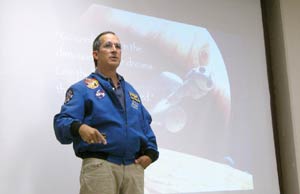First Native astronaut had to overcome his own inertia
By Cindy Yurth
Tséyi' Bureau
TSAILE, Ariz., August 1, 2013

"I got to hang off rocks for a living," he said. "I didn't see how it could get any better than that."
Herrington, who had been expelled from the University of Colorado in Colorado Springs with a 1.72 GPA because he spent all his time rock-climbing instead of studying, was able to find a job with a survey crew.
"I would hang off the side of a cliff holding a prism," the first Native American astronaut told a packed auditorium at Diné College, where he was a guest speaker at what might have been the Navajo Nation's first math camp. "Then a guy would shoot a beam of light at the prism, and they could tell by the angle it came out at if they were shooting it at the right angle. Light always moves in a straight line."
It was Herrington's first time really experiencing math, and he thought it was pretty cool.
But hey, who cared about math when you could hang off rocks for a living, making $4 an hour?
Luckily, Herrington's supervisor did. Or at least, he cared about Herrington.
"He called me in one day and said, 'John, have you given any thought to what you're going to do after this?'" Herrington recalled.
Like most 19-year-old males, Herrington really hadn't. He was at the top of his game, and the moment was a pretty good place to live.
His supervisor persisted.
"You can't raise a family on four dollars an hour," he told the youth. "Why don't you go back to school?"
Luckily, Herrington took his advice, or the Native American community might still be waiting for its first astronaut.
As for what to major in, well, Herrington thought the prism thing was pretty cool. This time, taking a lesson from the prism, he focused on his studies. He ended up with a degree in applied mathematics.
Another chance encounter, this time with a friend who had joined the Navy, made him think, "Hmm, maybe I should do that."
He applied to the Naval Academy in 1983 and received his commission a year later.
Harrington eventually became a test pilot, and after learning many astronauts had a background as Naval test pilots, he went on to earn his master's in aeronautical engineering before applying to NASA. He was accepted in 1996.
"It was a lot of hard work," he said of his journey, "but it was also that I was in the right place at the right time."
After all that experience and education, Herrington found himself right back where he started from – hanging off something. In 2002, on the 16th Space Shuttle mission, the Chickasaw tribal member was chosen for a space walk. With a partner, he installed a piece of equipment on the International Space Station.
"As a rock climber," said Herrington, "it was the ultimate place to be — on the edge of a 220-mile cliff."
On that mission, Herrington performed three spacewalks totaling nearly 20 hours.
Shortly thereafter, however, he was diagnosed with osteoporosis and told he wouldn't fly on the space shuttle again. It was a major disappointment, but he did have one more adventure with NASA before retiring, serving as commander of the NEEMO 6 underwater laboratory in 2004.
So what does a retired astronaut do?
Herrington at first got involved with the commercial space industry, but when it became apparent that was not exactly moving at the speed of light, he resigned and has since been working for his tribe and accepting public speaking engagements such as the one in Tsaile Friday.
He's also trying to make sure there are some young Native Americans following in his footsteps. In 2008, he embarked on Rocketride, riding a bicycle across the country diagonally, from Cape Flattery, Wash. to Cape Canaveral, Fla., to raise awareness of math and science education among Native tribes.
You would think riding a bicycle would be pretty tame after walking in space, but Herrington described Rocketride as a "life-changing experience." For one thing, he met the woman who would become his wife.
In conclusion, Herrington told the kids, "I did a remarkable thing. Everybody here has that exact same potential."

